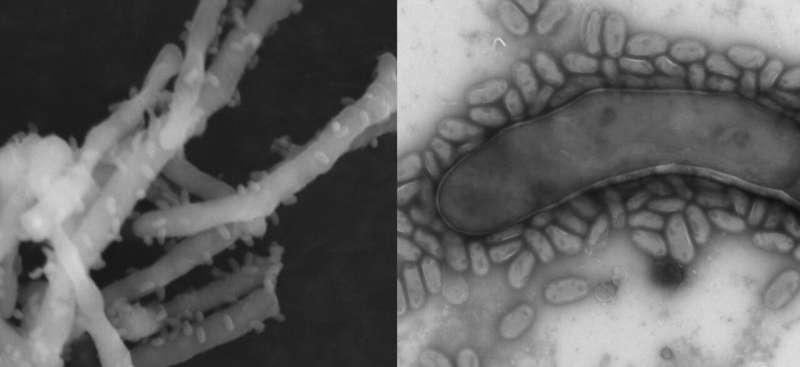Ultrasmall parasitic bacteria (Mycosynbacter amalyticus) attach to the larger wastewater foaming bacterial cells (Gordonia pseudoamarae) leading to cell lysis. Imaged under scanning electron microscope. Credit: La Trobe University
Researchers from La Trobe University have made a promising discovery that could pave the way to solving a costly and hazardous problem encountered by wastewater treatment plants the world over.
Associate Professor Steve Petrovski, who shared his finding in a new paper published in Nature Microbiology, said wastewater treatment plants can be plagued by operational problem caused by foam created by certain bacteria.
"This foam reduces the quality of effluent and creates a hazardous work environment at the plant. It costs the industry billions of dollars each year and makes the plants inefficient, yet there are no effective ways to control these foams."
Associate Professor Petrovski works focuses on "bacteriophages," viruses that infect and kill bacteria.
"One particular bacterium—Gordonia amarae—is notorious for causing persistent and stable foams in wastewater treatment plants. Through our work to isolate a phage that will target G. amarae, we accidentally stumbled across another potential solution—a previously unknown microscopic parasite attached to the bacterium."
The team at La Trobe sequenced G. amarae's genome and identified previously unknown defense mechanisms which explained why the bacteria is so difficult to combat with bacteriophages.
"But the microparasite, which we have named Mycosynbacter amalyticus, latches onto G. amarae and in fact kills it. This may represent a promising biocontrol strategy to prevent wastewater foaming."
Associate Professor Petrovski said the find was very exciting.
"Some organisms related to G. amarae can also cause disease in humans and animals such as nocardiosis and bacteremia, and this novel ultrasmall bacterium could potentially be the cure."
More information: Steven Batinovic et al. Cocultivation of an ultrasmall environmental parasitic bacterium with lytic ability against bacteria associated with wastewater foams, Nature Microbiology (2021). DOI: 10.1038/s41564-021-00892-1
Journal information: Nature Microbiology
Provided by La Trobe University
























